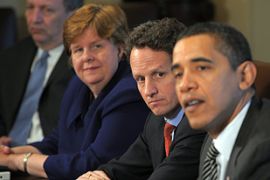US stocks soar on bank asset plan
Dow closes at highest level in months after government says it will buy “toxic assets”.

The US also received further positive economic news on Monday, with the National Association of Realtors saying that sales of existing homes grew 5.1 per cent to an annual rate of 4.72 million last month from 4.49 million units in January – the largest sales jump since July 2003.
However, the average sales price plunged to $165,400, down 15.5 per cent from $195,800 a year earlier.
Obama ‘very confident’
On Monday, Obama said that his economic team remained “very confident” that this latest effort to aid ailing banks would work.
 |
| Investors welcomed the “toxic asset” plan, driving the Dow up nearly seven per cent [EPA] |
“We believe that this is one more element that is going to be absolutely critical in getting credit flowing again. It’s not going to happen over night. There’s still great fragility in the financial systems. But, we think we are moving in the right direction and we are very confident,” he said.
Timothy Geithner, the US treasury secretary, said on Monday in a newspaper article that the plan was part of the US government’s strategy to “resolve the [financial] crisis as quickly and effectively as possible at least cost to the taxpayer”.
“We [must] strike the right balance between our need to promote the public trust and using taxpayer money prudently to strengthen the financial system, while also ensuring the trust of those market participants we need to do their part to get credit flowing to working families and businesses,” he wrote in the Wall Street Journal.
The US treasury’s plan comes at a crunch time for the US administration, as Obama prepares to meet fellow leaders of the world’s top 20 economies at a financial summit in London on April 2.
Al Jazeera’s Rosiland Jordan, reporting from Washington DC, said the Obama administration considered the programme the “least bad option” of all the others they were discussing, exposing the US government to the least possible amount of risk rather than letting the slump continue and risking a second economic depression.
The plan
The US government has poured billions of dollars into US banks after many suffered huge losses following the subprime mortgage crisis and from the global economic turmoil.
However, many still hold these “toxic” mortgage-related assets on their books, making the institutions reluctant to lend money to businesses and citizens.
Initially, the treasury will put $75bn to $100bn to launch the scheme, taking the money from the $700bn financial rescue bailout approved last October.
The government money would be put alongside private capital and then leveraged up to $500bn, or possibly double that amount, with the help of the Federal Deposit Insurance Corporation, a US bank regulator, and the Federal Reserve.
Under the plan, the government will provide the lion’s share of the funding to buy up the “toxic assets”.
And private-sector purchasers will establish the value of the loans and securities purchased under the programme themselves to protect the government from overpaying for the assets.
Criticism
The plan has been criticised by some economists, with James Galbraith, an economist and professor of government at the University of Texas in Austin, telling Al Jazeera that the plan would not work as the problem itself had been “misconceived”.
“This is not a blockage where our problem is the banks are unwilling to lend, this is a problem of deep depression and collapse in asset values,” he said.
|
“You cannot fix this problem by stuffing money into the banks” James Galbraith, economist |
“Without addressing the underlying problems of employment, income and household incomes we’re not getting out of this.
“You cannot fix this problem by stuffing money into the banks. When it fails we’re going back to where we started and we’ll need to address those underlying issues.”
Paul Krugman, a recent winner of the Nobel prize for economics, dismissed the government’s move as “cash for trash” in a news article, saying it failed to address fundamental flaws in the US financial system.
“The Obama administration is now completely wedded to the idea that there’s nothing fundamentally wrong with the financial system – that what we’re facing is the equivalent of a run on an essentially sound bank,” he wrote in a column for The New York Times on Saturday.
“And I fear that when the plan fails, as it almost surely will, the administration will have shot its bolt: it won’t be able to come back to congress for a plan that might actually work.”
Some Republicans supported the plan on Monday, with Mitch McConnell, the senate minority leader saying he gave Geithner “credit for finally turning to the real issue here”, though he reserved judgement on whether the plan would work.
| In depth |
 |
But other Republicans have criticised the plan and called on Geithner to resign, calls Obama has rejected.
The US president is also struggling to contain public anger over big bonuses paid by insurer AIG that has been bailed out with $180bn in taxpayer money.
On Monday, Andrew Cuomo, the New York attorney-general, said 15 of the 20 employees who received some of the largest bonuses from AIG had agreed to return the money.
But that would amount to only about $30m of the $165m the ailing insurance giant paid out in bonuses this month.